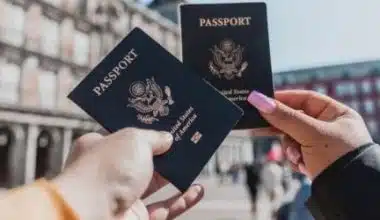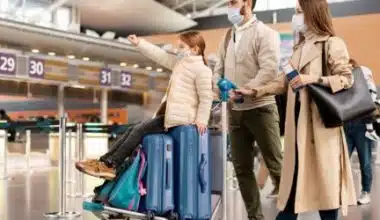To slow the spread of COVID-19, the government of Peru has imposed some travel restrictions on both its people and foreign visitors. Take a few minutes to read the most recent Peru travel restrictions before organizing your next trip, whether it’s for business or pleasure. Read on to learn how to modify your schedule when entering Peru, including details on the documents needed to enter the country and the rules that must be observed there.
As the COVID-19 situation in Peru changes, the travel limitations do as well; therefore, stay current with the most recent information provided on the redBus website. RedBus provides a wide range of bus alternatives that adhere to safety regulations to the letter. Continue reading to learn more about the travel limitations to Peru, the paperwork you need to bring, and the safety precautions you should take when there.
Peru Travel Restrictions
Although thousands of tourists from across the world are coming to Peru to see the most incredible locations, like Machu Picchu, the country is safe for travelers, but like any destination, there are some safety issues that visitors should keep in mind.
The state of emergency that had been in force in Peru since March 2020 has ended, and all travel restrictions and occupancy caps have been lifted.
Peru’s COVID-19 protection regulations changed as a result of vaccination campaigns and population growth. Both the country’s land and air borders reopened in February 2022 and October 2020, respectively. To enter the country or its indoor places, visitors are no longer required to produce identification, complete the immigration and health declaration, or provide documentation of a negative COVID test. Masks are also no longer necessary. Previously, proof of vaccination (including boosters) and KN95-style respirators or double masks (considering the current epidemic and the risks of Long Covid, they’re still suggested) were required to access many indoor venues.
What Are the Current Travel Restrictions in Peru?
All visitors over the age of 12 must have a vaccination card that includes the necessary doses as well as the booster for those who are over 18 and eligible. If not, they must present a negative PCR test that was performed no more than 48 hours before boarding.
All passengers above the age of 12 must have the necessary doses for domestic flights and interprovincial land travel, as well as the booster for travelers who are Peruvian residents over the age of 18 and are eligible to receive it. A negative PCR test conducted no more than 48 hours before boarding is necessary otherwise.
In enclosed settings, you must always use a KN95 face mask or a double mask.
It is necessary to present the immunization card with the finished dose before entering closed establishments like restaurants, bars, cafes, or shopping centers.
In areas where adults aged 60 and older have received three doses of the COVID-19 vaccine and where people aged 12 and older have received two doses of the vaccine, wearing a face mask in public places is not required.
For US citizens, re-entering the country does not require the COVID-19 test.
Peru Travel Restrictions: Covid
All tourists above the age of 12 must have a vaccination card with all necessary doses completed to enter Peru, or they must present a negative PCR test that was performed no more than 48 hours before travel. These limitations are continuously reviewed. Face masks are not always required to be worn in public areas.
The benefit of traveling to Peru during COVID-19 is that there are rarely any tourists at the tourist attractions. Going to Machu Picchu in the current iteration is a privilege because, before the plague, it was on the verge of being overrun with tourists. Above all, keeping in mind our stringent COVID-19 standards, we work to maintain a high degree of security so that we can confidently show you stunning locations like Machu Picchu or the Sacred Valley. In addition, we provide a high degree of flexibility in case you need to cancel or delay your trip to Peru.
COVID-19 Information in Peru
Peru has been classified as having COVID-19 at Level 2, or moderate, by the Centers for Disease Control and Prevention (CDC). It is strongly advised that everyone gets vaccinated before embarking on any overseas journey because those who are fully protected with an FDA-authorized vaccination have a lesser risk of contracting an infection and becoming seriously ill while visiting Peru.
The Peruvian government, on the other hand, likewise reviews and modifies its regional alert levels and mobility restrictions every two weeks. Depending on the situation on the ground, these measures are rated as moderate, high, very high, or extreme. All parties, including citizens of the United States, are required to abide by these rules.
When entering businesses and other public areas, it is necessary to follow minimum health precautions and standards, such as double-masking and staying 6 feet apart.
Peru Restrictions on Health and Safety
Except in a few regions, hand sanitizer use is required everywhere in the country, including outside, along with a 1.5-meter social distance, masks, and routine hand washing.
To travel on public roadways and in enclosed locations, one must wear either a single KN95 mask or a double mask (a surgical mask with a cloth mask on top). These include shopping centers, grocers, banks, etc. It is advised to wear two masks and a face shield.
Anyone over 18 must present a vaccination record (vaccination certificate) to enter any enclosed public place.
Every traveler who wants to access tourist attractions, restaurants, cars, airlines, trains, and other locations must abide by the law on body temperature detection. If your temperature is higher than 37.5° C, it will be automatically recorded. Please be aware that if your body temperature is higher than 37.5° C, access to a certain venue or location may be denied.
Peru Travel Restrictions for Your Machu Picchu Visit
To help travelers move more easily throughout Machu Picchu, the Peruvian government has created a few regulations and health guidelines. Before traveling to Machu Picchu, it is advised that visitors familiarize themselves with these guidelines. For example
- According to requirements set forth by train and bus companies, all passengers must travel with two face masks or one KN95 mask.
- According to Machu Picchu park management, all visitors must abide by this rule. Park officials will eject anyone who disobeys these rules.
- A group tour can only include a maximum of 10 individuals, including the tour guide.
- At bus stops, entry and departure points, restrooms, and places with considerable traffic, visitors are required to adhere to the social distance standards and maintain a space between themselves of 1.5 meters.
Travel Documents to Enter Peru
You might require a tourist visa, a current passport, or your national identification card to enter Peru, depending on your nationality, for instance.
- Passport: Concerns to all nations outside the Andean Community It needs to be valid for at least six months.
- Tourist Visa: Applies to travelers from Cuba, El Salvador, Nicaragua, Venezuela, Haiti, and Haiti.
- National Identity Card: Valid for every Andean Community member, including Colombia, Ecuador, Bolivia, Chile, and Argentina.
New Requirements to Enter Peru: COVID-19
As previously noted, everyone wishing to enter Peru must present updated documentation, according to the immigration office. Land borders are currently blocked because of the epidemic; however, air borders are still open. Therefore, flying internationally is the only option to travel to Peru from elsewhere.
You only need to produce your vaccination card if you finished your coronavirus vaccination doses (two or one, depending on the kind and booster) 14 days before your arrival in the country.
- If you have not had all of your recommended vaccinations, you must show a negative PCR test with a result date no later than 72 hours prior to boarding your first flight.
- Each traveler must complete the Health Affidavit Form, or Declaración Jurado de Salud, at least 72 hours before departure.
- Entry of non-resident aliens from the Republic of South Africa or those who have visited this nation during the previous 14 days of their arrival is now suspended.
- If the visitor or resident tests positive for the coronavirus, they must submit to a 14-day mandatory quarantine.
Remember that these requirements must be presented while checking in for your flight, and the immigration officer in Peru may also require these documents.
Recommended Immunizations for Peru
Are there any immunization requirements to enter Peru? is a common query from travelers thinking about visiting the area. No, there isn’t an official vaccination requirement in Peru; however, there are some suggestions for those who intend to stay there for an extended period of time.
- We advise getting the yellow fever vaccine if you want to travel to the jungles of Peru.
- You should think about getting the rabies vaccine if most of your travel will take place outdoors and you’ll be in close proximity to bats and monkeys.
- Hepatitis A, Hepatitis B, Typhoid, and diphtheria vaccines are a few other ones that are advised for visitors.
Before agreeing to receive any of these vaccines, we encourage you to see a qualified medical advisor. Please consult a travel physician regarding the need to repeat some vaccinations after a specific time.
If you intend to travel during these times, we strongly advise that you familiarize yourself with all the information and guidelines published by the governments of the places you intend to visit. We are aware of how tedious it could be, but as long as you have all the necessary paperwork, everything will be right.
As of right now, the WTTC has designated Peru as one of South America’s safest tourist destinations after awarding it the Safe Tourist Seal. While you’re here, learn everything you need to know before visiting Peru!
Is It Easy to Find Work in Peru?
It’s difficult, as previously mentioned, to simply show up here in Peru and find employment within the short months you have while visiting the nation. Therefore, it is strongly advised to have enough money saved up to maintain yourself while looking for work.
Do I Need a Vaccination to Travel to Peru?
Yes, some vaccinations are advised or necessary for Peru. Hepatitis A, hepatitis B, typhoid, yellow fever, rabies, meningitis, polio, measles, mumps, and rubella (MMR), Tdap (tetanus, diphtheria, and pertussis), chickenpox, shingles, pneumonia, and influenza vaccinations are all advised for Peru by the CDC and WHO.
Do I Need a Visa to Travel to Peru?
Hepatitis A and tetanus are frequently recommended as courses or boosters. Other vaccines to take into account are yellow fever, typhoid, rabies, hepatitis B, and diphtheria. None of the immunizations are recommended for people who are at the greatest risk. There is no need for a certificate of yellow fever vaccination in this nation.
Are US Dollars Accepted in Peru?
Which currencies are recognized in Peru? Nuevo Both US dollars and Peruvian soles are frequently accepted in Peru. When using USD, there can nevertheless be a little disadvantage. If you pay in USD, the price of a good or service may be marginally higher, albeit typically not by much.
How Long Can I Stay in Peru Without a Visa?
Up to 183 days are allowed for tourist stays in Peru. Foreign nationals from nations requiring a tourist visa who do not currently reside in the UK are required to receive specific authorization from the immigration office in Lima before they can apply for a visa. The processing of this application can take several days.
Can I Get a Visa on Arrival in Peru?
Visas are not provided upon arrival in Peru. Indian nationals who possess valid visas for the US, Canada, the UK, Australia, or the Schengen region can instead travel without a visa.
Summary
Generally speaking, you may get a PCR test at any general hospital or health facility in Peru; however, some private facilities demand that you make reservations in advance, at least 12 hours before your flight. Therefore, be prudent, book your reservations in advance, and carry on with your activities.
Finally, each nation has its own unique rules and limitations for both citizens and visitors. Only an antigen test is required of North American and US nationals before they can return home.
- BEST PERU VACATIONS DESTINATION IN 2023
- BEST PERU VACATION TOURS & TRAVEL AGENCIES
- PLACES YOU CAN GO WITHOUT A PASSPORT IN 2023
- THE ULTIMATE TRAVEL ESSENTIALS LIST (With Travel Packing Tips)
- TURKS AND CAICOS VACCINE REQUIREMENTS: All You Need To Know






